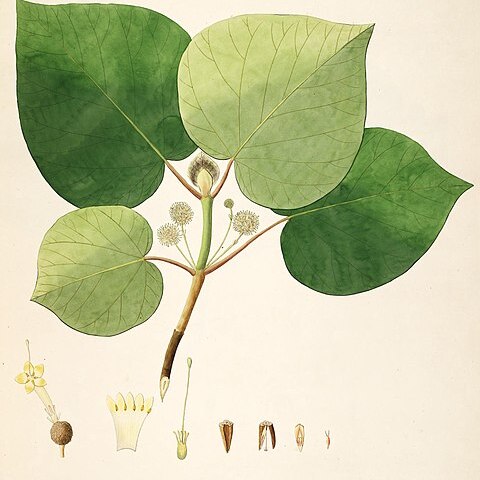Trees, deciduous, 7-30(-40) m tall; trunk often buttressed and fluted at base, with outer bark reddish brown, inner bark dark red to brown; branches stout, with well-developed petiole scars. Petiole 2-12 cm, densely tomentulose to pilosulous; leaf blade drying thinly leathery, brown adaxially, and pale to yellowish green abaxially, broadly ovate, (5-)8-16(-25) × (5-)8-16(-20) cm, adaxially sparsely hirtellous to puberulent or glabrescent, abaxially densely puberulent, tomentulose, pilosulous, or glabrescent and with epidermis bullate inside areoles of quaternary veins, base cordate, apex acute to acuminate; secondary veins 6-10 pairs, usually divaricately branched half way along their length, sometimes with pilosulous domatia; stipules spatulate, ovate, or oblong-oblanceolate, 10-12 × 5-12 mm, usually strongly keeled, densely strigillose to pilosulous, broadly rounded. Inflorescence densely tomentulose to pilosulous; peduncle 2-6(-10) cm, at articulation with 2 bracts 1-2 mm, broadly rounded; flowering heads 5-8 mm in diam. across calyces, ca. 20 mm in diam. across corollas; bracteoles linear to clavate, ca. 2 mm. Calyx densely strigillose; ovary portion 1-2 mm, densely sericeous, surrounded at base by a dense ring of trichomes 1-2 mm; limb deeply lobed, lobes narrowly triangular to linear, 1.3-1.8 mm, at apex clavate. Corolla outside densely strigillose; tube 5-6 mm; lobes elliptic-oblong, 1-2 mm, obtuse to rounded. Stigma ovoid, ca. 0.2 mm, exserted for 5-7 mm. Fruiting heads 10-15 mm in diam. Capsules 4-5 mm, densely strigillose or glabrescent near base; seeds 2-3.5 × 0.5-1 mm. Fl. spring and summer.
More
A deciduous tree. It grows 30 m high. The trunk is erect and the branches are horizontal. The bark is brownish-grey and furrowed. The leaves have leaf stalks. They are rounded or heart shaped and hairy underneath. The leaves are 20-25 cm long. The flowers are yellow. They occur as round heads 2-4 cm across. These contain several small flowers. The fruit is a capsule. It is round. It has 6 seeds.
Rainforests at elevations from 300-1,000 metres in China. Scattered in mixed deciduous forests in India. Usually growing along rivers or transitional areas between swampy wetlands and dry loamy areas, which are flooded for short periods.
More
A tropical plant. It grows in forested areas in tropical and subtropical regions. It grows up to about 800 m altitude in Nepal. In India it grows in dry forests in hilly parts of the country. In Yunnan.

